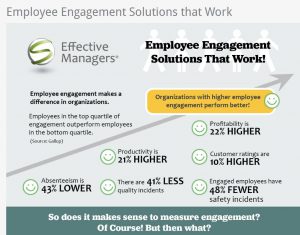
Establishing a culture of employee engagement can address common problems in the workplace such as poor communication and poor collaboration which lead to dips in productivity. Here are 6 ways to promote a company culture that values employee engagement.
1. Clarity
Our research shows that almost all managers feel accountable for doing good work. And yet less than half feel they are delegated clear objectives. In this hectic world that leaves managers having to choose from conflicting priorities without enough information. Part of your role as a manager is to be clear about priorities. There is always more to do than can be done, so help your team understand where to focus.
2. Model the Behavior
For employees to adopt a culture of employee engagement, they must first see it being promoted by their managers who show commitment to making their day-to-day experiences meaningful.
Managers can do this by weaving engagement into daily interactions such as one-on-one meetings or action planning sessions. There is an opportunity every day to show employees that you are engaged, even if it is a 15-minute morning team meeting that intends to set the pace for the rest of the day.
According to a study by Gallup, almost 7 in 10 employees strongly believe that employees whose managers focus on their strengths are more engaged.
3. Transparency
Trust is a key component of employee engagement, and it can be established through transparency and accountability. When leadership communicates what drives the company and what its long-term goals are, employees can recognize how they fit into the bigger picture. Employees want to trust their leaders will guide them to future success. They also want to believe that they play a valuable role in achieving it.
4. Visibility
Executives and managers need to be accessible and approachable; they can achieve this by being visible. Employees who regularly see their organization’s leaders engage with team members and check in on people occasionally show that they are available for guidance and support.
When managers are visible, it shows they care. It tells their employees that they are prepared to offer their assistance and listen to their concerns. According to Office Vibe, 70% of employees would like to spend more time with their manager. An open-door policy is a good thing, but be clear with your team what that means.
5. Training
When employees are provided with the proper training from the start, you equip them with the resources they need to perform their jobs. And when you provide opportunities for continuous learning, you are showing employees that you support their potential to grow and develop. This makes employees feel valued and become invested in the success of the organization.
6. Work Together, Play Together
While leaders should always find opportunities to engage with their employees to some extent every day, there are times when activities outside the norm are necessary. Activities such as team buildings or even volunteering together offer teams the chance to engage casually.
When teams find ways to break up routines in order to encourage creativity, they also promote a more collaborative company culture. When teams bond over activities outside of their daily work routine, they better recognize each other’s strengths and weaknesses. Team members who understand one another become better at communicating and working as a unit.
At Effective Managers, we believe that when an organization works to improve the accountability of its management team, employees feel more engaged in their work – and that leads to a more productive organization.
If you want to learn more, let’s connect: dwight@effectivemanagers.com
Learn more about employee engagement and how it can drive improved organization performance. The answer may surprise you.
Check out our YouTube channel for free VidCasts and recorded Webinars.







